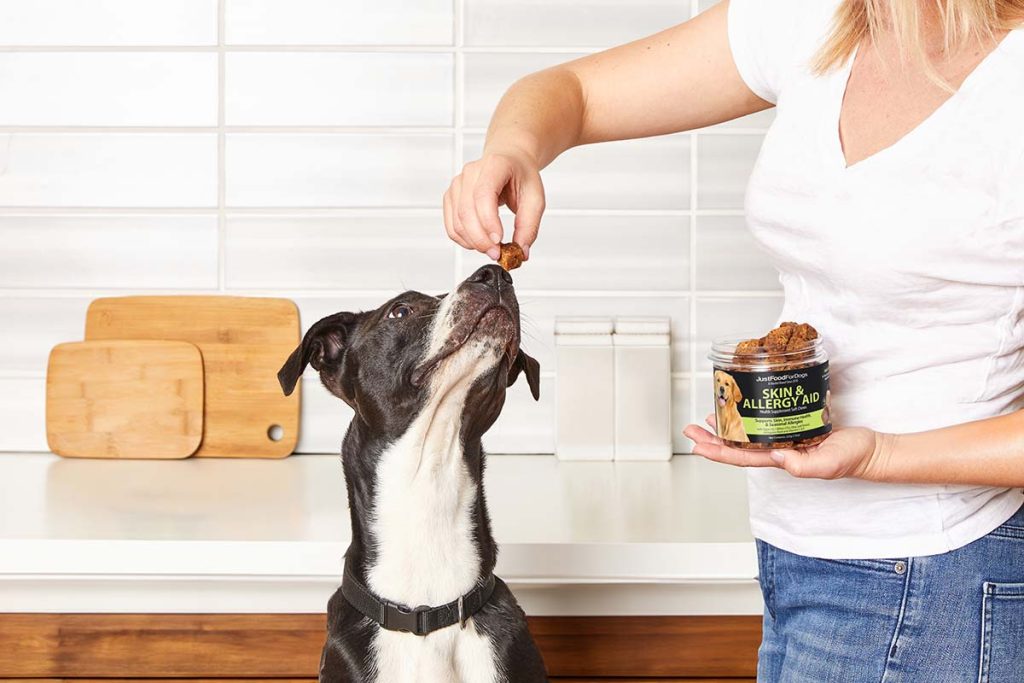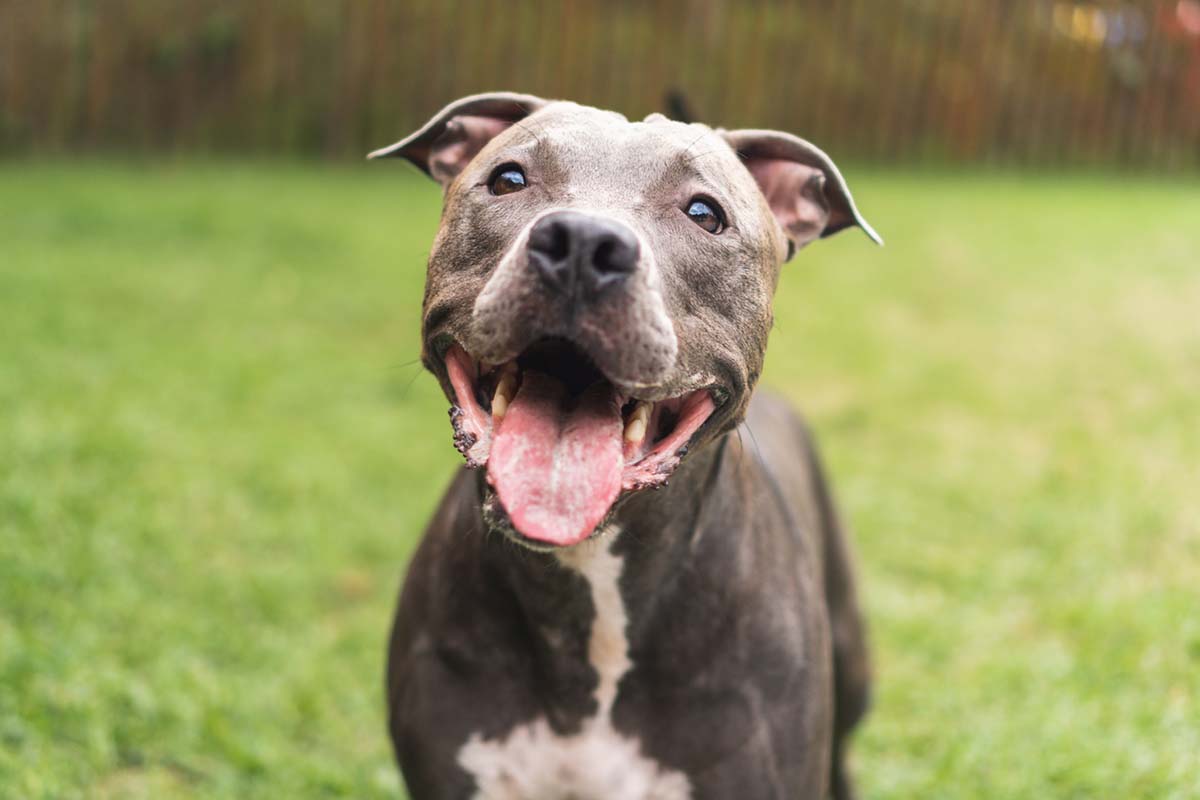As loving pet parents know, dog skin care is crucial to his overall wellness and quality of life. You and your dog’s skin is one of the body’s largest and most sensitive organs. It is one of the first lines of defense against infections, pests, and other environmental factors.
But just like humans, your furry friend can experience a variety of skin issues—some of which are unique to specific breeds. Let’s delve into the essentials of dog skin care, common skin conditions, and breed-specific considerations to help keep your dog comfortable and their coat shining.
Why Does Skin Care Matter for Dogs?

Healthy skin and a lustrous coat are signs of a happy, well-nourished dog. However, a range of environmental, nutritional, and genetic factors can lead to skin issues. Some common causes of skin issues in dogs include:
- Parasites like fleas, ticks, and mites
- Seasonal allergies or allergies from food or other environmental factors
- Infections caused by bacteria or fungi
- Hormonal imbalances and underlying medical conditions
A proactive approach to skin care can help prevent discomfort, avoid secondary infections, and allow you to catch signs of deeper health issues early.
Common Skin Conditions in Dogs

There are a variety of reasons why your dog might have sensitive skin. If your best buddy has skin problems, it’s important to determine the cause before trying to treat the problem. Let’s look at some common reasons your pooch might be feeling uncomfortable in his own skin.
1. Allergies
Allergies are one of the most common causes of skin irritation in dogs. Various factors can trigger them:
- Environmental allergies: Pollen, dust, mold, and grasses can cause symptoms such as itching, redness, and inflammation.
- Food allergies: Certain ingredients in dog food, like grains or specific proteins, may trigger skin reactions. This can cause rashes and itchy skin, particularly on your buddy’s belly and legs.
- Flea allergy dermatitis: Even a single flea bite can lead to an intense allergic reaction in some dogs.
Dogs with allergies may exhibit symptoms like itching, licking, hair loss, and redness. In severe cases, scratching may lead to wounds or secondary bacterial infections.
Treatment often involves eliminating the allergen, using hypoallergenic shampoos, and sometimes medications, like anti-bacterial topical treatments.
2. Hot Spots
Hot spots, or acute moist dermatitis, are inflamed, red, and moist areas of skin that develop due to excessive scratching, licking, or chewing. These may be caused by allergies, poor grooming, or parasites.
Hot spots can be painful and need prompt attention, as they can rapidly worsen. The affected area should be cleaned and treated with an antibiotic or anti-inflammatory ointment prescribed by a veterinarian.
3. Dermatitis
Dermatitis refers to general inflammation of the skin and can be triggered by various factors, including parasites (like mites and fleas), poor grooming, or environmental irritants. Symptoms include redness, itching, and flaky skin.
Regular grooming, a high-quality diet, and flea prevention may help prevent or manage dermatitis.
4. Mange
Mange is a skin disease caused by mites and is classified into two main types:
- Sarcoptic mange: Highly contagious, causes intense itching and hair loss.
- Demodectic mange: Caused by Demodex mites, often found on the skin naturally but can cause issues if the immune system is compromised.
The condition requires veterinary treatment, typically with medicated baths, ointments, or oral medications to kill the mites.
5. Dandruff
Dandruff in dogs, often caused by dry skin, can lead to itchiness and discomfort. Nutritional deficiencies, poor grooming, or even dehydration can contribute to dandruff. Ensuring a balanced diet, regular grooming, and using moisturizing dog shampoos may help reduce dandruff.
6. Yeast Infections
Yeast infections commonly occur in areas like the ears, paws, and skin folds. They often produce a strong odor and can cause itching, redness, and a greasy or waxy texture on the affected skin.
Yeast infections can develop due to allergies or a weakened immune system and are treated with antifungal shampoos or medications.
7. Bacterial Infections
Bacterial skin infections, known as pyoderma, can arise as secondary infections due to open wounds, allergies, or underlying skin issues. They often present as pimples, redness, and oozing sores. Treatment typically involves antibiotics and proper wound care.
What are Some Breed-Specific Skin Conditions?

Some dog breeds are more prone to certain skin issues due to genetics, coat type, or skin structure. Understanding your dog’s breed-specific predispositions can help you take preventative measures. Here are some common breeds and their typical skin conditions.
1. Bulldogs, Pugs, and Shar Peis: Skin Fold Dermatitis
Breeds with excessive skin folds, like Bulldogs, Pugs, and Shar Peis, are more susceptible to skin fold dermatitis. These folds create warm, moist environments where bacteria and yeast can grow. This leads to irritation, infection, and odor.
Regularly cleaning these folds with a gentle, non-irritating cleanser and drying them thoroughly may help prevent infections.
2. Bully Breeds, Golden Retrievers, and Labradors: Allergic Dermatitis
Golden Retrievers and Labradors are prone to atopic dermatitis, an inflammatory condition often caused by environmental allergens. Symptoms include itchy skin, redness, and sometimes hair loss.
These breeds benefit from regular baths with hypoallergenic shampoos and can sometimes require prescription medications to control symptoms.
3. Dachshunds: Acanthosis Nigricans
Acanthosis nigricans is characterized by darkening and thickening of the skin, particularly in the armpits and groin areas. This condition, common in Dachshunds, can be managed with anti-inflammatory treatments, though it can be progressive.
4. West Highland White Terriers: Epidermal Dysplasia
West Highland White Terriers are prone to epidermal dysplasia, a genetic disorder leading to thickened skin, itchiness, and secondary infections.
These dogs often require ongoing management. It includes medicated shampoos, antibiotics for infections, and sometimes dietary adjustments to control symptoms.
5. Boxers and Airedale Terriers: Seasonal Flank Alopecia
Boxers and Airedale Terriers may experience seasonal flank alopecia, where patches of hair fall out, typically in the fall or winter months. While it’s usually a cosmetic issue without discomfort, some owners use melatonin supplements (with veterinary approval) to help promote hair regrowth.
6. Poodles, Akitas, Bichon Frises, Lhasa Apsos, and English Springer Spaniels: Sebaceous Adenitis
Sebaceous adenitis, a condition where the sebaceous glands become inflamed, affects breeds like Poodles and Bichon Frises. Symptoms include dry, scaly skin, hair loss, and an unpleasant odor. Treatment includes medicated shampoos and sometimes oral medications.
What are Some Essential Dog Skin Care Tips?

- Groom Regularly: Regular brushing helps distribute natural oils across your dog’s skin, removes dead fur, and allows you to check for any signs of irritation or parasites.
- Bathe Carefully: Overbathing can strip the skin of natural oils, leading to dryness. Use a gentle, moisturizing dog shampoo suited to your dog’s skin type, and bathe only as necessary.
- Balanced Diet: High-quality, nutrient-rich food is essential for a healthy coat. Look for diets that contain omega-3 and omega-6 fatty acids, which promote skin health and a shiny coat.
- Prevent Parasites: Use vet-approved flea, tick, and mite preventatives to avoid infestations that can lead to skin irritation and infections.
- Stay Hydrated: Ensure your dog has access to clean, fresh water at all times. Hydrated skin is less prone to dryness and irritation.
- Watch for Environmental Triggers: Be mindful of seasonal allergens, household cleaning products, and other environmental factors that may trigger skin reactions in sensitive dogs.
- Consult Your Vet: Regular check-ups can catch skin problems early before they become severe. Your vet can also recommend appropriate treatments for any underlying health issues that may contribute to skin conditions.
When Should You Consult a Veterinarian?

While some mild skin irritations can be treated at home with gentle products and good grooming practices, certain symptoms warrant a vet visit. If your pet has any of the following symptoms, schedule a visit with his vet.
- Persistent itching or redness
- Unusual hair loss or bald patches
- Sores, oozing, or crusting skin
- Strong odor from the skin or ears
- Skin that appears to be thickening or darkening in areas
Early diagnosis and treatment can prevent discomfort and more severe complications.
How are Dog Skin Problems Treated?
Treating dog skin problems typically involves a combination of topical, oral, and preventive measures depending on the underlying cause. Here’s a closer look at common treatments for dog skin conditions:
1. Topical Treatments
For many skin issues, especially those localized to a specific area, topical treatments with specialized skin care products are effective and widely used. These include:
- Medicated Shampoos: Shampoos with ingredients like chlorhexidine, benzoyl peroxide, or salicylic acid can help manage bacterial infections, seborrhea, and excessive oil or dandruff. Anti-fungal shampoos are also available to treat yeast infections.
- Ointments and Creams: These are often used for smaller areas of inflammation or infection, such as hot spots. Antibiotic ointments are applied to prevent bacterial infection. Corticosteroid creams may reduce inflammation and itching. For yeast infections, anti-fungal creams are often prescribed.
- Sprays: Topical sprays can be an alternative for dogs who dislike creams or lotions. Anti-itch sprays with hydrocortisone or lidocaine help alleviate itching and soothe irritated skin.
Regular application is essential, and you may need to use some products for weeks to see improvement. Always consult your vet before starting a new topical treatment, as certain ingredients can be toxic if ingested by your best friend.
2. Oral Medications
Some skin conditions require oral medications, especially when the issue is widespread or when topical treatments alone are ineffective.
- Antibiotics: For bacterial infections, your vet may prescribe oral antibiotics like cephalexin or amoxicillin. These help treat and prevent secondary infections that arise from excessive scratching or open wounds.
- Anti-fungal medications: For systemic yeast infections or severe cases, your vet may prescribe oral anti-fungal medications like ketoconazole or itraconazole.
- Anti-allergy Mmedications: For dogs with allergies, antihistamines (like diphenhydramine or cetirizine) can reduce symptoms. More severe allergic dermatitis might require immunosuppressive drugs or corticosteroids, although these are usually short-term solutions due to potential side effects.
- Anti-inflammatory drugs: Corticosteroids, both topical and oral, help reduce inflammation and alleviate itching, although they are generally used short-term due to side effects like increased thirst and appetite.
3. Dietary Adjustments and Supplements
Dietary changes play a significant role in managing skin conditions related to food allergies or nutrient deficiencies.
- Hypoallergenic Diets: Dogs with food allergies may benefit from hypoallergenic diets that eliminate common allergens, such as chicken, beef, dairy, or grains. Novel protein diets or hydrolyzed protein diets may help.
- Supplements: Omega-3 and omega-6 fatty acids are beneficial for skin health and are in salmon oil and other fish oils, as well as flaxseed oil and algae oil supplements. These fatty acids help reduce inflammation, improve coat quality, and alleviate dryness.
- Probiotics: Some vets recommend probiotics for dogs with recurrent infections or allergies, as a healthy gut microbiome can influence skin health.
4. Preventive Measures
Preventing skin problems can reduce the frequency and severity of outbreaks.
- Regular Grooming: Brushing, bathing, and inspecting your dog’s coat helps prevent issues like mats and parasites.
- Flea and Tick Control: Monthly flea and tick preventatives prevent infestations that lead to itching, hot spots, and infections.
- Environmental Management: Avoiding allergens or frequenting areas free from known irritants can reduce reactions in allergy-prone dogs.
For severe cases, a combination of these treatments may be necessary. Consistent follow-up with a veterinarian is essential to monitor progress and adjust treatments as needed.
Good Skin Care for Dogs is Comprehensive

Dog skin care is about being proactive. While some dogs are naturally more prone to skin issues, regular grooming, a balanced diet, and attention to breed-specific needs can keep most skin problems at bay.
While this is just one aspect of taking good care of your pooch’s skin, it’s an important one to add to your dog’s skin care regimen.
Just as you do with yourself, it’s important to take a proactive, comprehensive approach to taking care of your dog’s skin. Not only will your dog look and feel better, but by understanding his unique skin care needs, you’re also helping him lead a happier, healthier life.
Citations
Moriello, Karen A. 2019. “Acanthosis Nigricans.” Merck Veterinary Manual. November 21, 2019. https://www.merckvetmanual.com/integumentary-system/acanthosis-nigricans/acanthosis-nigricans.
“Beauty Isn’t Even Skin Deep: New Study from the Royal Veterinary College Finds That Flat-Faced Dogs Are at the Highest Risk of Skin Fold Dermatitis.” n.d. Www.rvc.ac.uk. https://www.rvc.ac.uk/vetcompass/news/beauty-isn-t-even-skin-deep-new-study-from-the-rvc-finds-that-flat-faced-dogs-are-at-the-highest-risk-of-skin-fold-dermatitis.
Shaw, Stephen C., James L. N. Wood, Julia Freeman, Janet D. Littlewood, and Duncan Hannant. 2004. “Estimation of Heritability of Atopic Dermatitis in Labrador and Golden Retrievers.” American Journal of Veterinary Research 65 (7): 1014–20. https://doi.org/10.2460/ajvr.2004.65.1014.
Scott, Danny W., and William H. Miller. 1989. “Epidermal Dysplasia and Malassezia Pachydermatis Infection in West Highland White Terriers.” Veterinary Dermatology 1 (1): 25–36. https://doi.org/10.1111/j.1365-3164.1990.tb00072.x.
Miller, M A, and R W Dunstan. 1993. “Seasonal Flank Alopecia in Boxers and Airedale Terriers: 24 Cases (1985-1992).” Journal of the American Veterinary Medical Association 203 (11): 1567–72. https://pubmed.ncbi.nlm.nih.gov/8288480/.
Hernblad Tevell, Elisabeth, Kerstin Bergvall, and Agneta Egenvall. 2008. “Sebaceous Adenitis in Swedish Dogs, a Retrospective Study of 104 Cases.” Acta Veterinaria Scandinavica 50 (1). https://doi.org/10.1186/1751-0147-50-11.
“The Importance of Your Pets Skin and Coat and the Role of Diet | VCA Animal Hospitals.” n.d. Vcahospitals.com. https://vcahospitals.com/know-your-pet/the-importance-of-your-pets-skin-and-coat-and-the-role-of-diet.
Scott, D W, H Miller, G A Reinhart, H O Mohammed, and M S Bagladi. 1997. “Effect of an Omega-3/Omega-6 Fatty Acid-Containing Commercial Lamb and Rice Diet on Pruritus in Atopic Dogs: Results of a Single-Blinded Study.” Canadian Journal of Veterinary Research 61 (2): 145. https://pmc.ncbi.nlm.nih.gov/articles/PMC1189391/.
This content is for informational use only and does not replace professional nutrition and/or medical advice, diagnosis, or treatment. It is not a substitute for specific nutrition and/or medical recommendations. Please talk with your veterinarian about any questions or concerns.
